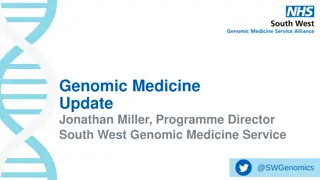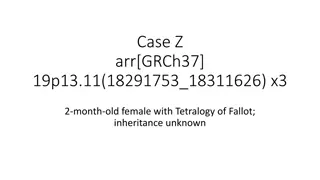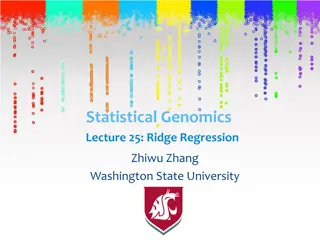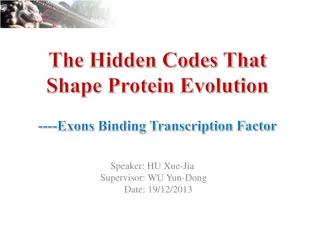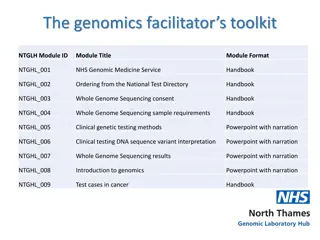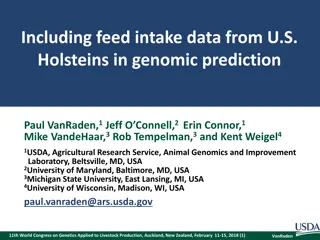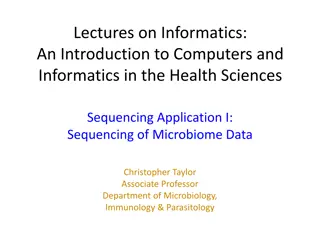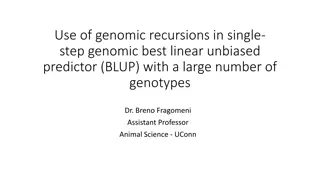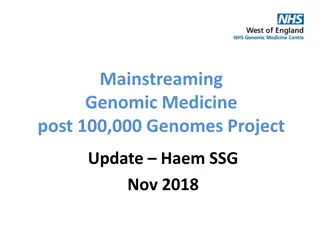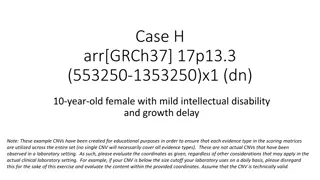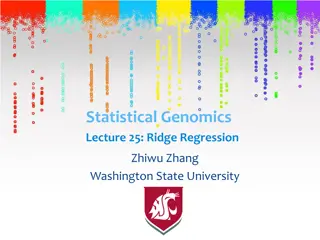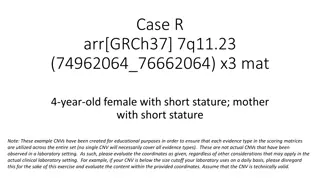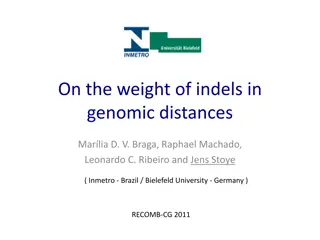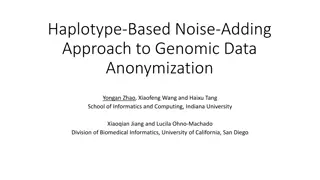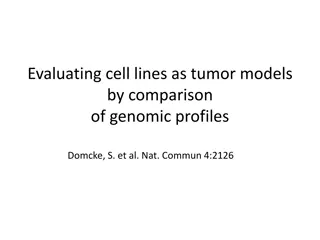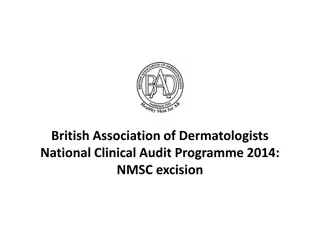
Understanding RAPD Technology for Genomic Analysis
Learn about RAPD (Random Amplified Polymorphic DNA) technology, a PCR-based method using single primers to amplify anonymous DNA fragments. Discover how PCR products are generated, the analysis of RAPD bands as independent loci, and the scoring of bands to create a binary matrix for statistical analyses.
Download Presentation

Please find below an Image/Link to download the presentation.
The content on the website is provided AS IS for your information and personal use only. It may not be sold, licensed, or shared on other websites without obtaining consent from the author. If you encounter any issues during the download, it is possible that the publisher has removed the file from their server.
You are allowed to download the files provided on this website for personal or commercial use, subject to the condition that they are used lawfully. All files are the property of their respective owners.
The content on the website is provided AS IS for your information and personal use only. It may not be sold, licensed, or shared on other websites without obtaining consent from the author.
E N D
Presentation Transcript
StudyMafia.Org RAPD Submitted To: Studymafia.org Studymafia.org Submitted By:
What is RAPD? RAPD is a PCR-based method which employs single primers of arbitrary nucleotide sequence with 10 nucleotides to amplify anonymous PCR fragments from genomic template DNA
RAPD technology A B C A + + + Arbitrary primers Taq polymerase Nucleotides + Genomic DNA PCR (under relaxed conditions) Buffer
PCR 360 bp Electrophoresis A B C 260 bp 520bp 360 bp 520 bp A B C 260 bp
PCR product occurs when: The primers anneal in a particular orientation (such that they point towards each other) The primers anneal within a reasonable distance of one another (150 -3000 bp)
The number of amplification products is related to the number and orientation of the genome sequences which are complementary to the primer 1 3 2 4 5 6 PCR reaction DNA template Product 1 Product 2
RAPD bands are treated as independent loci: 1 2 3 4 5 6 7 8 9 10 11 12 13 14 Locus A Locus B Locus C Locus D 1 2 3 4 5 6 7 8 9 10 11 12 13 14 AA/ Aa bb aa aa aa aa aa aa aa aa aa aa aa aa aa BB/ Bb cc BB/ Bb cc BB/ Bb cc BB/ Bb cc BB/ Bb cc BB/ Bb cc BB/ Bb cc BB/ Bb cc bb bb bb bb bb CC/ Cc CC/ Cc CC/ Cc CC/ Cc CC/ Cc cc DD/ Dd DD/ Dd DD/ Dd DD/ Dd DD/ Dd DD/ Dd DD/ Dd DD/ Dd DD/ Dd DD/ Dd DD/ Dd DD/ Dd dd dd
RAPD bands are scored for presens 1 and absens 0 . Only clear, consistent and polymorphic bands are usually used to create a binary matrix for future statistical analyses
A binary matrix: Band 1 1 0 1 1 0 1 1 Band 2 0 1 1 1 1 0 0 Band 3 0 0 1 0 0 0 1 Band 4 1 1 0 1 1 1 0 Plant A Plant B Plant C Plant D Plant E Plant F Plant G
Statistical analyses (some examples) Measurements of genetic diversity by means of different genetic diversity indexes (i.e. Nei s diversity index, modified by Lynch and Milligan (1994) for dominant markers, Shannon s index etc)
Evaluation of genetic diversity in Lingonberry populations Table 1. Analysed populations of lingonberry, number of plants sampled, location of population, within-population gene diversity (including standard error) estimated by the Lynch and Milligan index (Hpop) and Shannon s index (H pop) Sampling site no. Sampling site code No. of plants Country Location Latitude (N) Longitude (E) Hpop H pop 1 2 3 4 5 6 7 8 9 10 11 12 13 14 15 SK S SV SN SG SH FT FS NS EV EP RM RK JF CM 15 15 15 10 13 11 15 15 15 15 10 15 14 14 15 Sweden Sweden Sweden Sweden Sweden Sweden Finland Finland Norway Estonia Estonia Russia Russia Japan Canada Kristianstad rebro V sterbotten Norrbotten G vleborg Halland Toijala Simo Sognedal V ru P rnu Murmansk Kirov Fuji San Montreal 56 13 59 24 63 37 66 42 60 18 57 05 60 13 65 41 61 12 57 55 58 25 68 55 58 53 35 20 45 50 14 12 14 39 19 51 19 33 16 46 13 20 24 10 25 01 7 05 27 03 24 40 33 05 49 30 138 45 73 50 0.227 (0.026) 0.214 (0.025) 0.245 (0.027) 0.197 (0.026) 0.248 (0.028) 0.219 (0.026) 0.187 (0.026) 0.178 (0.026) 0.225 (0.029) 0.241 (0.029) 0.209 (0.027) 0.110 (0.024) 0.135 (0.024) 0.180 (0.028) 0.274 (0.025) 0.483 (0.049) 0.517 (0.051) 0.513 (0.050) 0.400 (0.051) 0.523 (0.048) 0.500 (0.051) 0.375 (0.049) 0.374 (0.050) 0.434 (0.055) 0.456 (0.055) 0.434 (0.055) 0.190 (0.043) 0.265 (0.047) 0.349 (0.056) 0.654 (0.048) x = 0.206 x = 0.431
Cluster analysis, Multidimensional Scaling and Principal co-ordinate analyses are used mainly for evaluation of genetic relatedness among individual organizms or among groups of organizms (i.e. populations)
Genetic relatedness among populations of lingonberry (A) and indidual plants of Japanese quince (B) revealed by cluster analyses Similarity (%) 100 90 80 70 60 50 40 B SH A SN FT SV FS SK S RM RK SG EV EP NS CM JF Fig.1. Dendrogram based on UPGMA analysis of genetic similarity estimates among 15 populations of lingonberry
Genetic relationships among lingonberry popula-tions (A) and individual plants of Japanese quince (B) revealed by MDS analysis A B Fig.2 An MDS analysis of genetic relationships Among ligonberry populations
A three-dimentional representation of phenetical relationships between populations of Japanese quince revealed by PCA
Genetic relationships among 23 cultivars from Gene bank at Balsg rd revealed by RAPD markers Similarity % Fig.1. Dendrogram based on UPGMA analysis (Jaccard s coefficient) for RAPD data, showing relationships among apple cultivars
Advantages: No prior knowledge of DNA sequences is required Random distribution throughout the genome The requirement for small amount of DNA (5-20 ng) Easy and quick to assay The efficiency to generate a large number of markers
Commercially available 10mer primers are applicable to any species The potential automation of the technique RAPD bands can often be cloned and sequenced to make SCAR (sequence- characterized amplified region) markers Cost-effectiveness!
Limitations: Dominant nature (heterozygous individuals can not be separated from dominant homozygous) Sensitivity to changes in reaction conditions, which affects the reproducibility of banding patterns Co-migrating bands can represent non- homologous loci
The scoring of RAPD bands is open to interpretation The results are not easily reproducible between laboratories
Applications: Measurements of genetic diversity Genetic structure of populations Germplasm characterisation Verification of genetic identity Genetic mapping
Development of markers linked to a trait of interest Cultivar identification Identification of clones (in case of soma- clonal variation) Interspecific hybridization
Verification of cultivar and hybrid purity Clarification of parentage
RAPD is probably the cheapest and easiest DNA method for laboratories just beginning to use molecular markers
References Google.com Wikipedia.org Studymafia.org Slidespanda.com
Thanks To StudyMafia.org

